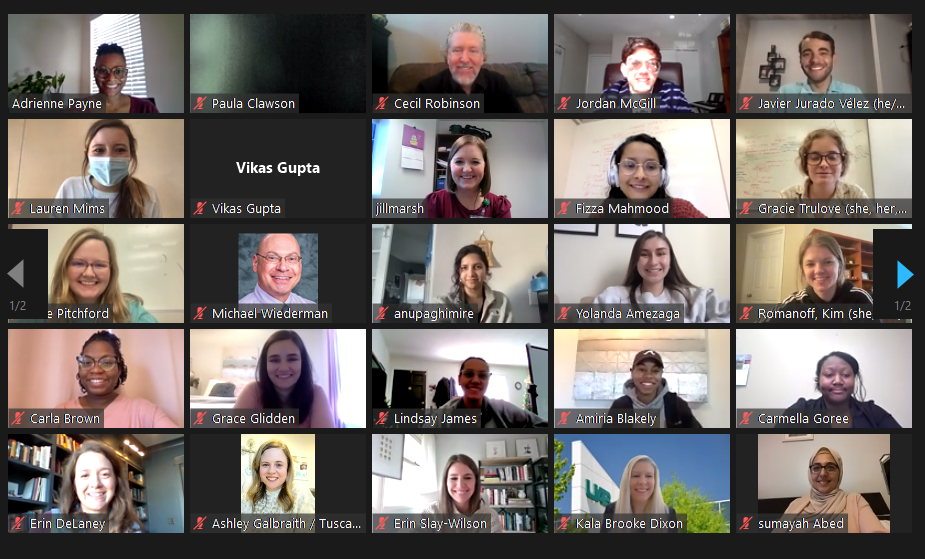
What began as a small, progressive program has quickly grown into a multi-campus initiative aiming to grow the number of primary care providers for the state of Alabama and address critical shortages. Since its launch in 2020, the Comprehensive Urban Underserved and Rural Experience (CU2RE) program has nearly tripled in size, expanded to all of the UAB Heersink School of Medicine’s campuses, and is on track to open a pipeline program for undergraduate students in 2022.
CU2RE, funded by a $7.5 million HRSA grant, is a complex program run by many dedicated physicians, program managers, and staff out of UAB’s Department of Family and Community Medicine.
“We are here to provide meaningful learning experiences where program content is relevant, engaging, and offers an enhanced understanding about the role primary care plays in building strong healthcare systems, positive outcomes, and health equity,” said CU2RE Program Director Adrienne Fowler Payne.
Payne and other leadership note the excitement they feel with the program’s growth in year two. The first cohort of eight students just finished their initial year of programming, and the second cohort, starting in January, brings 15 new students to the program.
“Our students have a strong desire to learn about and address the needs of medically urban underserved and rural patient populations in the state of Alabama,” Payne said. “CU2RE plays a role by offering extracurricular educational opportunities to prepare and guide students to a medical career in primary care. We aspire to continually increase program enrollment and have opportunities to connect with more students in the years to come.”
Extracurricular opportunities include a patient panel, in which students are paired with 10 patients that they will follow over the course of their medical training and serve as health coaches, early clinical training that begins when they start medical school, service learning, and hybrid learning modules that prepare students to become compassionate and innovative primary care leaders. Now that CU2RE is expanding to other campuses, program leaders expect the impact to multiply.
“The growth we have seen in just one year of CU2RE is encouraging,” said Jill Marsh, M.D., director of the rural and urban underserved pathways. “We have engaged deeply-committed family medicine partners at all UAB regional campuses, and the snowball effect of growing our student and faculty cohorts has led to even greater shared excitement about the future of primary care at UAB and for the state of Alabama.”
CU2RE now includes students from all of UAB’s medical campuses. All CU2RE students will spend time learning about primary care and telehealth, studying health disparities, conducting research, and understanding how to provide culturally competent care for different patient populations. The CU2RE team in Birmingham works closely with regional faculty and coordinators to ensure that the CU2RE students receive all the benefits of the program at their campus alongside their CU2RE peers. This model builds continuity and collaboration among UAB’s medical campuses, another goal of the CU2RE grant.
First-year CU2RE students like Laura Catherine Cresswell, from Arab, Alabama, are excited to begin the curriculum in January 2022.
“Primary care is the first line of defense in healthcare,” Cresswell noted when discussing what drew her to primary care in the first place. “It’s most patients’ first interaction with a health care provider, so I think it is very important to make them feel supported to build the foundation.”
Cresswell and other students are paired with a faculty mentor who will work with them one-on-one throughout medical school. Her upcoming mentorship and 10-patient panel are the two program components that most excite Cresswell.
“I liked the idea of having a patient panel that I follow throughout my time in medical school,” she said. “One of the key parts of treating people in rural areas is creating meaningful, long-lasting relationships. I am excited to see this firsthand!”
Similar to Cresswell, first-year medical student Amiria Blakely was drawn to CU2RE because of her passion for primary care and the chance for earlier clinical exposures.
“I am most excited about the hands-on learning experience,” said Blakely. “I’m thankful that I will have the opportunity to work with a set of patients who will allow me to play a role in their health care.”
Blakely will finish medical school at the Tuscaloosa campus, and the CU2RE program will follow her there. She and other Tuscaloosa-bound students will work with program site directors Cecil Robinson, Ph.D., and Grier Stewart, M.D.
Javier Jurado Velez, part of the urban underserved pathway, is ready to learn more about the holistic side of primary care through CU2RE’s integrated curriculum.
“From housing and food access to mental well-being, multiple aspects of a patient's livelihood can accentuate the health inequities they may experience,” he said. “I applied to the CU2RE program since it offered a unique opportunity to work closely with patients from underserved communities in a well-rounded, longitudinal program.”
Velez and the other students have a lot to look forward to, as well as hard work ahead of them as they begin. As the CU2RE program continues to grow, leadership is looking to the future for inspiration and innovation.
“CU2RE, and all its related programming, is a great step for us to take for Birmingham and our state,” said Irfan Asif, M.D. Asif serves as the department chair, professor and associate dean for primary care and rural health in the UAB Heersink School of Medicine. He is also the principal investigator for the CU2RE program grant.
“The program hinges on providing students with early clinical exposures and educational experiences that enforce the innovation that is and must continue to happen in primary care,” he noted. “Telehealth, practice transformation, working well on an interprofessional team—these are all necessary skills for our students to learn as they grow into the next generation of primary care leaders.”
Meet all of the new members of the second CU2RE cohort here.